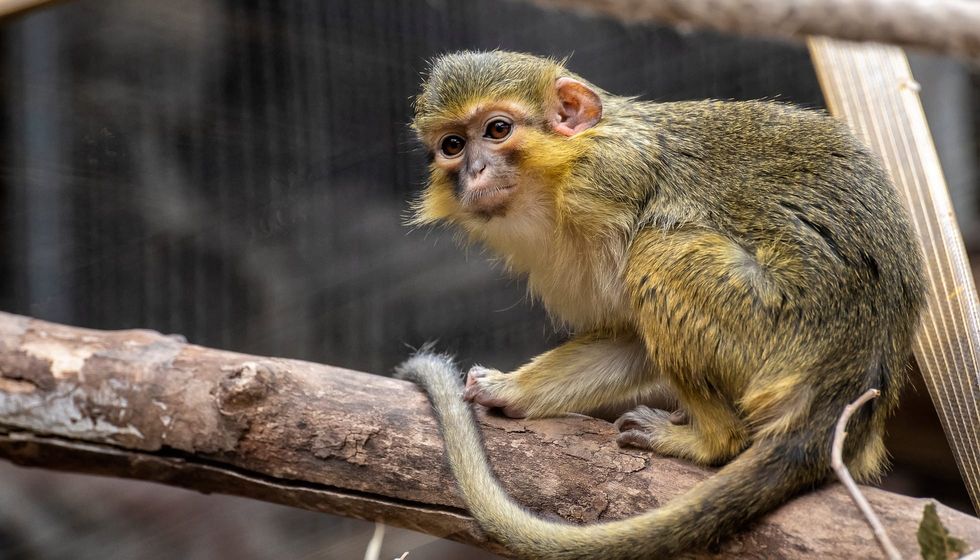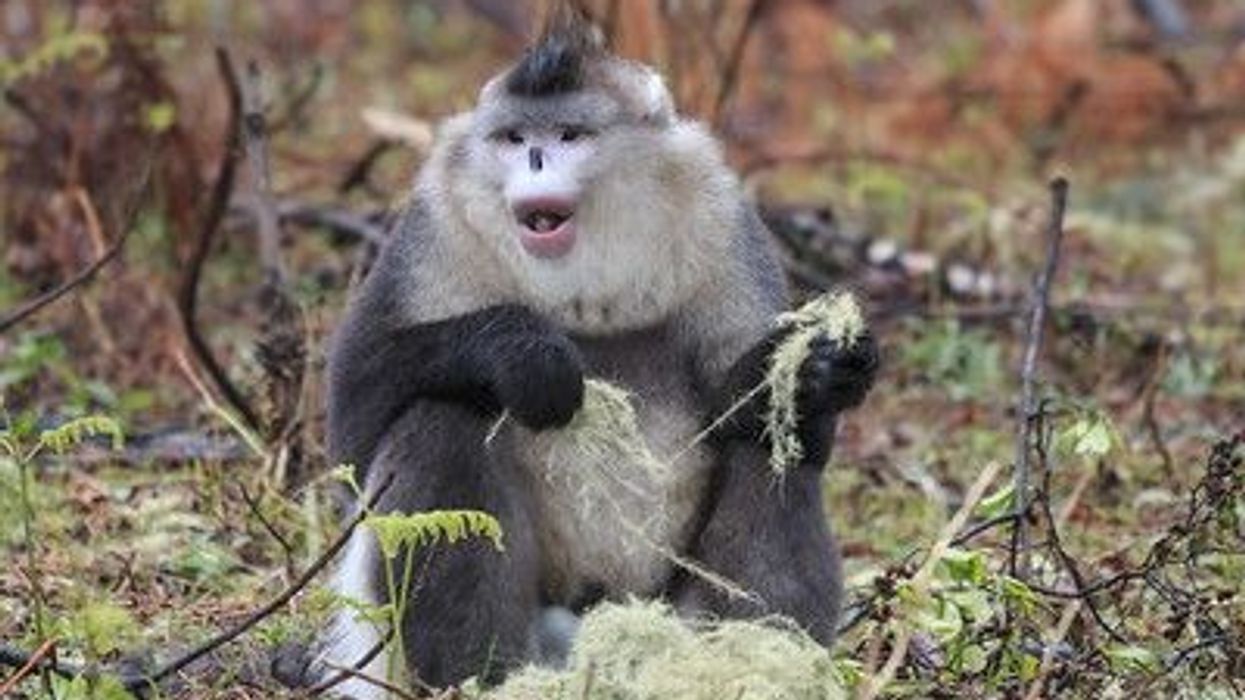Talapoin monkeys are a species of Old World Monkeys that are actually made up of two separate species of monkeys, the Gabon Talapoin Monkey (or the Northern Talapoin Monkey) and the Angolan talapoin Monkey (or the Southern talapoin Monkey).
Both these species belong to the Miopithecus genus. They are both found in the West Central African evergreen forests near rivers.
The Gabon talapoin animals are found closer to the Ogooué river from which they get their name Miopithecus ogouensis.
The Angolan talapoin animals (Miopithecus talapoin) live further south from the Gabon Talapoins, ranging from Angola to Cameroon. The most noticeable difference in the appearance of these monkeys is that the Gabon talapoin Monkeys have ears that are flesh-colored and the Angolan talapoin Monkeys have dark and blackish ears.
Both their populations are in decline due to overhunting and habitat loss, with Gabon talapoin Monkeys being 'Near Threatened' and Angolan Talapoin Monkeys being 'Vulnerable' under the IUCN.
For more relatable content, check out these red-tailed monkey facts and langur monkey facts pages.
Talapoin Monkey Interesting Facts
What type of animal is a talapoin monkey?
Talapoin monkeys of the genus Miopithecus are primates and Old World monkeys.
What class of animal does a talapoin monkey belong to?
The talapoin monkey species of the genus Miopithecus belongs to the Mammalia class of animals.
How many talapoin monkeys are there in the world?
The exact number of the Old World talapoin monkeys in the world is unknown, but both the species, the Northern talapoin monkey (Gabon Talapoin) and the Southern talapoin monkey (Angolan Talapoin) show declining trends of population.
Where does a talapoin monkey live?
The Gabon talapoin monkey is found in forested and close-to-river habitats of Western Central Africa in Gabon, Angola, Cameroon, the Republic of the Congo, and Equatorial Guinea. It is found close to the Ogooué, Nyong, Djérem, and Congo rivers. The Gabon talapoin monkey may have an even larger habitat range. They live south of the Angolan or Northern Talapoins.
Northern talapoin monkeys are found in the Western Central African riparian habitats too, but further north than the Southern talapoins. They are seen from Angola to the Democratic Republic of the Congo to Cameroon.
The rivers and the watersheds that they live close to are the Congo, Mebridege, Loge, Cuanza, Nhia, Cuango, Cuvo, and Kasai rivers. The Miombo woodland biome range sees a significant distribution and number of the Angolan Talapoins (Miopithecus talapoin).
What is a talapoin monkey's habitat?
Since they are prone to high degrees of predation, the Gabon talapoins as well as the Angolan talapoins (Miopithecus talapoin) favor thick evergreen forests near rivers to avoid predators. They also favor the lowland forested areas near the equator and swamps.
Gabon talapoins are rarely found more than 1,600 ft (500 m) away from a freshwater river, but this range may be larger for Angolan talapoins due to narrower forest strips and scarce resources.
They also tend to inhabit lands near farms and cultivations as their predators tend to avoid human-occupied areas and there is greater availability of food. They like living high in trees.
Whom do talapoin monkeys live with?
Gabon and Angolan talapoins are both highly social creatures that may live in groups as big as 100 individuals. For Gabon talapoins, the average group size is 12-20, and for Angolan talapoins, it is 60-70. Even though they live together, the males and females rarely interact outside the breeding season.
How long does a talapoin monkey live?
In captivity, both species of the talapoin monkey are known to live for around 28 years. In the wild, because of the high risk and frequency of predation, they may live much shorter lives.
How do they reproduce?
Talapoin monkeys' reproduction is by mating and giving birth.
The reproductive months of Gabon talapoins are from June to August and birth is given, usually to one infant, between November and April after a gestation period of 150-180 days. The infant is cared for beyond the reproduction season by the mother for three months after birth, after which it becomes independent.
Angolan talapoins (Miopithecus talapoin) form reproductive pairs during May-September, and after mating and the gestation period of around 160 days, infants are born between November and March. Usually, one infant is born after gestation, and females become adults sooner than males at around 4.5 years, and males become mature after 5.5-6.5 years.
What is their conservation status?
According to the IUCN, the conservation status of the Gabon talapoin monkey is 'Near Threatened', and that of the Angolan Talapoin Monkey is 'Vulnerable'.
Talapoin Monkey Fun Facts
What do talapoin monkeys look like?
Gabon Talapoin females are 9.1-13.4 in (23-34 cm) long, and the males are 10-14 in (26-36 cm) long from head to body, and their tails are 12.2-17.7 in (31-45 cm). Adult males are heavier in weight than females.
The tails are 12-18 in (31-45 cm). Gabon talapoins have large heads and flesh-colored faces and ears. The adults and juveniles don't show much difference in colors.
Gabon talapoins have short hairs all over their bodies. They have a yellow-olive crown that is grizzled and a golden-yellow coat. They have tails with dark tips and thin limbs.
They also have dark streaks on their noses and cheeks and their lips and eyelids are both yellowish. Gabon Talapoins also have pouches on their cheeks that they use for storing food.
Angolan Talapoins are (32-45 cm) long from head to body and have tails that are 14-21 in (36-53 cm) long. The head and eyes are big and the snout is short. The upper halves of their bodies are a greenish-gray to a greenish-yellow and the lower halves have a grayish-white look.
The ears are dark and they have facial yellow whiskers and black hairs around the nose. The outer limbs have a chrome-yellow or reddish color.
The feet and the hands of Angolan monkeys are also chrome-yellow with a reddish or pale tint. The brownish-black and yellowish-gray tails have dark tips. Juveniles and females are paler than adult males.

How cute are they?
Talapoin monkeys are very cute animals. They are the smallest, most adorable Old World monkeys. They are a combination of beautiful green, olive, golden colors, with emotive faces and long tails.
They utter beautiful bird-like calls and also hold hands to show affection. They exhibit really endearing human-like traits like grooming, petting, and nursing each other. They are also able to feel compassion, fear, anger, hate, and love.
How do they communicate?
Talapoin monkeys let out sharp whistles when looking out for predators in a community. There are 11 different vocalizations that these monkeys use that sound bird-like.
Males are known to scowl, bob their heads, and lash their tail tips to convey hostility. Gabon talapoins make an 'uh' sound while foraging, with the male call being lower-pitched than females, and juveniles make a sound more like a 'coo'.
They also use a 'pant chirp' which is a call to join an attack. These monkeys also indulge in grooming, hand-holding, and petting each other.
How big is a talapoin monkey?
Talapoin monkeys have a head-body length of 9.1-15.8 in (23-40 cm) and a tail length of 12–21 in (31-53 cm) (tail length), which makes them two times bigger than the pygmy marmoset and 2-4 times smaller than mandrills.
How fast can a talapoin monkey jump?
It is unclear exactly how fast the monkeys of the talapoin species can jump, but since it sleeps in trees at night despite its terrestrial habits, it can be assumed that it is an efficient and quick climber.
How much does a talapoin monkey weigh?
Talapoin monkeys' weight is anywhere between 1.8-4.2 lb (0.8-1.9 kg).
What are the male and female names of the species?
Males and females of the talapoin monkey species do not have specific names.
What would you call a baby talapoin monkey?
A baby talapoin monkey would be called an infant.
What do they eat?
Talapoin monkeys eat a diet of fruits, seeds, leaves, and invertebrates. More specifically, they eat a diet of plums, figs, musanga tree, mokenjo tree, African ginger nuts, insects like beetles, orthopterans, caterpillars, spiders, bananas, pawpaws, maize, cassava tubers.
How active are they?
Talapoin monkey animals are very active during the day. They are always climbing trees or foraging. They live in trees near rivers to avoid becoming food to various species of predators like leopards, genets, golden cats, raptors, snakes, and Nile monitors.
Would they make a good pet?
No, they would not make a good pet. They play a crucial role in their ecosystems since they feed on insects thereby controlling their populations.
They also disperse the seeds of various fruit species and they are also prey to many larger predators. And considering their habitat, they may possibly carry zoonosis, a disease that can possibly jump to humans from wild animals.
These animals are still victims of unlawful trafficking in Europe for the pet market, which should be stopped. Their populations should also be protected from hunting and habitat destruction.
Did you know...
The genus Miopithecus is synonymous with the two separate talapoin monkey species. Since there are no other animals that fall under the classification, only these two species make up the genus.
Pygmy marmosets are the tiniest species of New World monkeys in the world, while talapoin monkeys are the smallest when considering Old World monkeys. Pygmy marmosets are the smallest overall.
Africa is home to many monkey species, many of them Old World monkeys, that may have long, short, or very short tails.
Baboons can be one of the most dangerous monkeys. They have attacked humans on occasion, they carry canines sometimes and in South Africa, there has been an incident where a man's forearms were severely injured by a baboon.
Can a talapoin monkey swim?
Monkeys of the talapoin species are formidable swimmers. They have to be because they live closer to rivers and swamps. They are also known to dive while foraging for food.
Is the talapoin monkey an omnivore?
Yes, the Talapoin monkey is an omnivorous animal and it feeds on foods like plums, figs, musanga tree, mokenjo tree, African ginger nuts, insects like beetles, orthopterans, caterpillars, spiders, bananas, pawpaws, maize, cassava tubers.
Here at Kidadl, we have carefully created lots of interesting family-friendly animal facts for everyone to discover! For more relatable content, check out these key deer fun facts or the Colobus monkey facts pages.
You can occupy yourself at home by coloring in our free printable talapoin monkey coloring pages.









